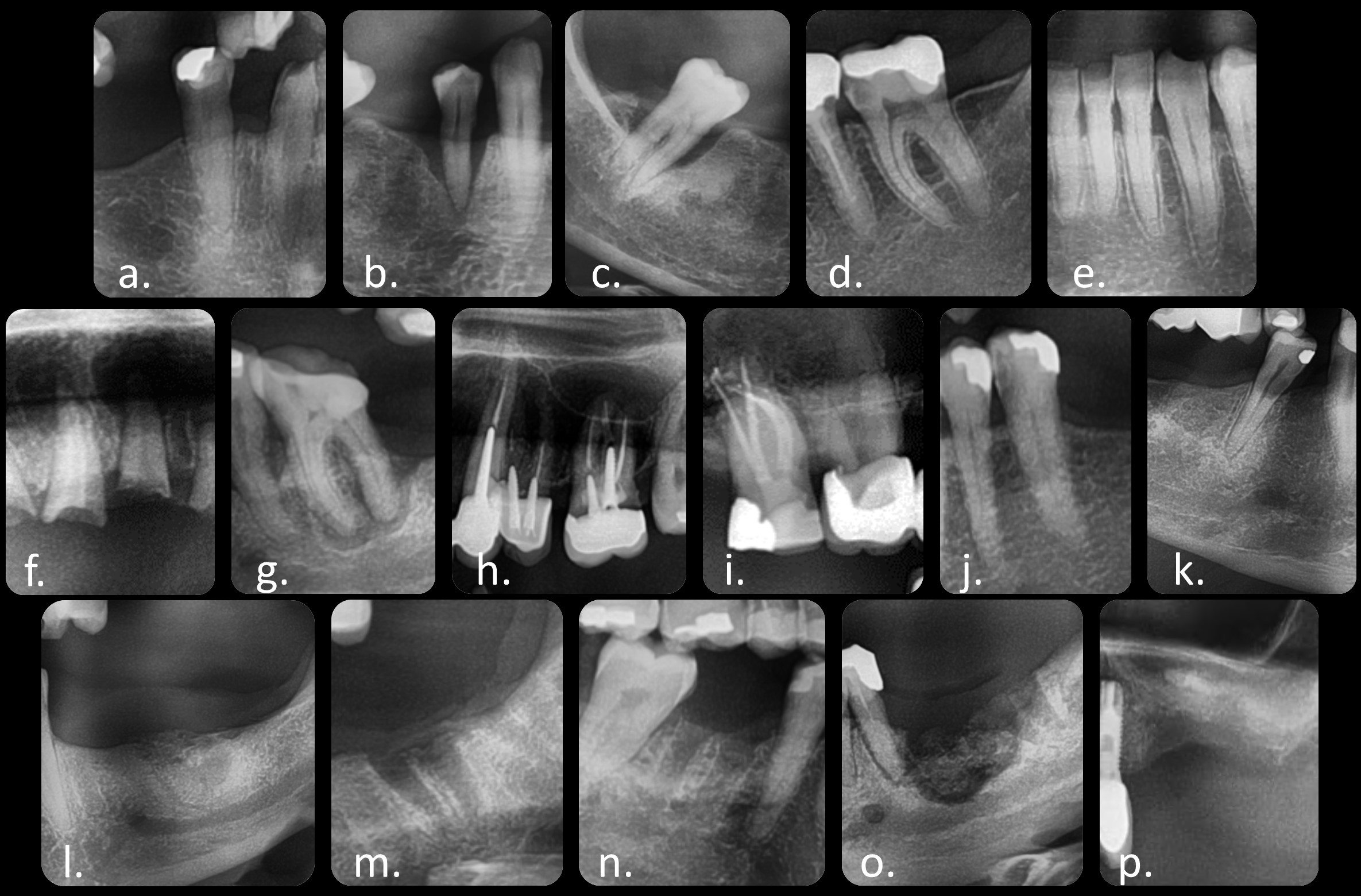IADR Abstract Archives
Radiographic Predictors of MRONJ in Patients Undergoing Tooth Extraction
Objectives: To identify local radiographic predictors of Medication-Related Osteonecrosis of the Jaw (MRONJ) in panoramic images of patients undergoing tooth extraction.
Methods: Through a retrospective search, patients were included if they were actively or previously treated with antiresorptive medication (ARM), underwent one or more tooth extractions, and had a pre- and postoperative panoramic radiograph. After data collection, blinded and independent observations were performed. Eleven distinctive imaging-related parameters were assessed preoperatively and five postoperatively, at every extraction site (Figure1). In addition to a case-control analysis, a subgroup analysis by ARM indication was performed assessing MRONJ development. Significance level was set at 5%.
Results: Between January 1st, 2010 and December 30th, 2019, 210 patients underwent tooth extraction from which 86 had an underlying oncologic diagnosis, and 124 had osteoporosis. The mean age of the oncologic and osteoporotic group was 68±12 and 69±11 years, the mean duration of the ARM treatment was 21 and 67 months, the number of extracted teeth were 269 and 383, with 69 (26%) and 16 (4%) of the teeth developing MRONJ, respectively. Additionally, a control group (n=108) that was age- (67.8± 10.7 years), number-of-extractions- (n=331), and sextant-of-extraction matched was selected. Preliminary results show that furcation involvement, caries, and changes in the bone pattern like sclerosis and heterogenous patterns were significantly more present in the MRONJ+ than in the MRONJ– group (p≤0.05). In addition, changes in the bone pattern, sequestrum formation, and crater-like defect showed an association with MRONJ+ in the postoperative parameters (p≤0.05).
Conclusions: MRONJ may be anticipated when recognizing furcation involvement, presence of pulpal caries, partial endodontic filling, and a sclerotic bone pattern in the to-be-extracted tooth. An heterogenous pattern, persistent alveolar socket, sequestrum formation, and crater-like defect could be signs of MRONJ after tooth extraction. This early identification encourages a patient-oriented decision making to avoid the onset of MRONJ.
Methods: Through a retrospective search, patients were included if they were actively or previously treated with antiresorptive medication (ARM), underwent one or more tooth extractions, and had a pre- and postoperative panoramic radiograph. After data collection, blinded and independent observations were performed. Eleven distinctive imaging-related parameters were assessed preoperatively and five postoperatively, at every extraction site (Figure1). In addition to a case-control analysis, a subgroup analysis by ARM indication was performed assessing MRONJ development. Significance level was set at 5%.
Results: Between January 1st, 2010 and December 30th, 2019, 210 patients underwent tooth extraction from which 86 had an underlying oncologic diagnosis, and 124 had osteoporosis. The mean age of the oncologic and osteoporotic group was 68±12 and 69±11 years, the mean duration of the ARM treatment was 21 and 67 months, the number of extracted teeth were 269 and 383, with 69 (26%) and 16 (4%) of the teeth developing MRONJ, respectively. Additionally, a control group (n=108) that was age- (67.8± 10.7 years), number-of-extractions- (n=331), and sextant-of-extraction matched was selected. Preliminary results show that furcation involvement, caries, and changes in the bone pattern like sclerosis and heterogenous patterns were significantly more present in the MRONJ+ than in the MRONJ– group (p≤0.05). In addition, changes in the bone pattern, sequestrum formation, and crater-like defect showed an association with MRONJ+ in the postoperative parameters (p≤0.05).
Conclusions: MRONJ may be anticipated when recognizing furcation involvement, presence of pulpal caries, partial endodontic filling, and a sclerotic bone pattern in the to-be-extracted tooth. An heterogenous pattern, persistent alveolar socket, sequestrum formation, and crater-like defect could be signs of MRONJ after tooth extraction. This early identification encourages a patient-oriented decision making to avoid the onset of MRONJ.

